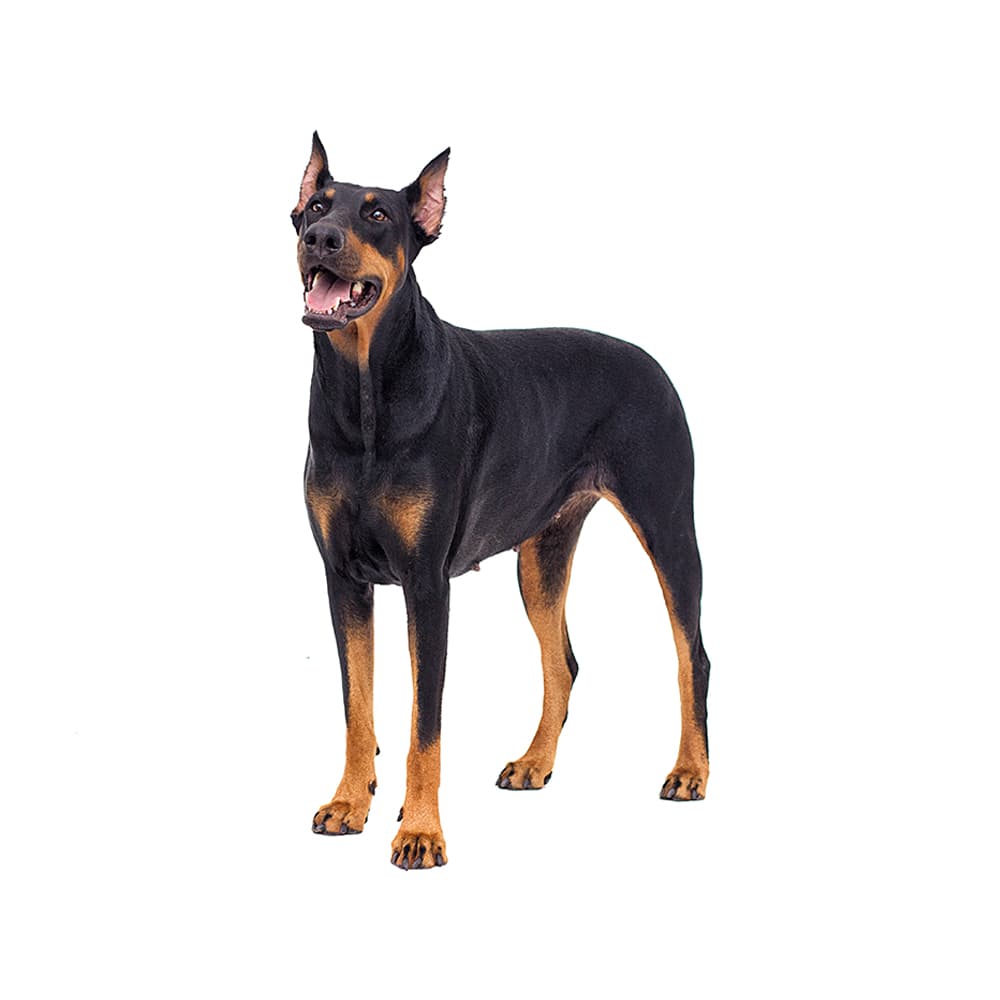Discover your dog's connection to this breed and 200+ others


Discover your dog's connection to this breed and 200+ others



The Doberman Pinscher, also known as Doberman, originated in Germany in the late 19th century, primarily by a tax collector named Louis Dobermann, who sought to breed an imposing, protective, and loyal dog for his dangerous line of work. The precise mixture of breeds used to create the Doberman is not fully known, but likely contenders include the Rottweiler, German Pinscher, Greyhound, and Weimaraner. Dobermans are excellent at police and military duties as well as therapy dogs and service dogs for the disabled. They also have worked search-and-rescue and participated in competitive dog sports. The breed quickly gained popularity and was officially recognized by the American Kennel Club (AKC) in 1908.
Dobermans can suffer from degenerative myelopathy, progressive rod-cone degeneration, hip dysplasia, eye disorders, autoimmune thyroiditis, and heart conditions. Genetic testing for these and other conditions including deafness and vestibular syndrome of Dobermans, dilated cardiomyopathy (DCM1 and DCM2), narcolepsy, oculocutaneous albinism (OCA), and von Willebrand Disease I can assist veterinarians with diagnosis and proactive care, as well as help breeders identify affected and carrier dogs.
Dobermans are known for their intelligence and protective instincts, which make them excellent guard dogs when properly socialized and trained. This breed is built strong, athletic, and alert. They are highly active and require regular mental and physical stimulation. They are also known to be adventurous, loyal, and obedient. Despite their sometimes intimidating appearance, they are usually friendly and very affectionate with their families, and can be good with children if they are raised with them. However, these dogs typically bond with one person. They may be reserved with strangers, so they need to be trained and socialized early on how to interact appropriately with other people and animals. Socialization and obedience training during puppyhood is crucial.
A canine genetic lineage is a group of individuals or entire breeds that descended from common ancestors predating modern breed formation. Often these lineages are associated with a ‘type’ of dog with a unique historical working role and associated behaviors (e.g., herding, scent hunting, etc.).
Herding dogs are known for their high intelligence, trainability, and strong work ethic. These breeds originated in areas where managing livestock was an important part of daily life and had large pastoral lands. These breeds were specifically developed to help farmers and shepherds move, manage, and protect herds of livestock. Breeds within the herding dog lineage are agile and are known to have a natural herding instinct, where they like to keep their animals together. They are loyal and attentive to their handlers and are eager to please and are also highly aware of their environment. Many breeds within this linage have gone on to work as rescue and police dogs.
Example breeds with ancestry from this lineage include Border Collie, Cardigan Welsh Corgi, and German Shepherd.
There is a life-size bronze statue of a Doberman in Guam at the war dog cemetary at the U.S. Naval Base in Orote Point. The monument is in memory of the Dobermans who lost their lives during World War II during the battle for Guam.
The Doberman originated around 1890 in Thueringen, Germany.
Their handsome looks and musculature has contributed to their fame as consisten winners in show rings, often winning awards such as Westminster's Best in Show.
https://www.fci.be/Nomenclature/Standards/143g02-en.pdf
https://www.ukcdogs.com/doberman-pinscher
https://www.ofa.org/recommended-tests?breed=DP
https://vgl.ucdavis.edu/panel/doberman-pinscher-health-panel
https://www.pawprintgenetics.com/products/breeds/114/
https://www.akc.org/dog-breeds/doberman-pinscher/
https://www.petmd.com/dog/breeds/c_dg_doberman_pinscher
Recommended by top vets with decades of experience
21 breeds
64 genetic health markers
50 genetic trait markers
